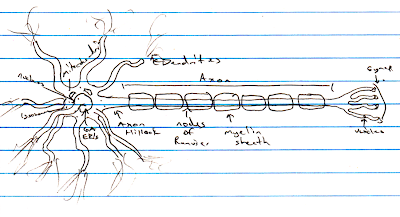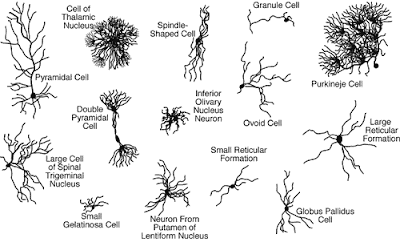We often make that mistake in teaching.
In my neurobiology class this semester, I asked my students on Day One to draw and label a picture of a neuron.
The pictures fell into two broad categories. About a third were unlabelled (some of them may not have heard me ask for the labels). Of the two thirds that were labelled, essentially all of them were vertebrate spinal cord motor neurons: a multipolar cell body and one long myelinated axon.
I’m puzzled as to why, of all the many types of neurons, these one have become viewed as “typical.” I know the trivial answer: they’re the ones shown in all the introductory general biology textbooks. And I understand why invertebrate neurons are not shown as examples, because neuroscience is mostly concerned with human brains.
Even within humans, spinal cord motor neurons are not typical. Many of the neurons in the brain are not myelinated (the “grey matter,” as it’s sometimes called). And neurons come in many shapes, and the axon is often not easily distinguished from all the other branches coming from the cell.
In teaching, we often make the same mistake of showing one example as representative, when it’s about as representative as the middle-aged white guy in a business photo.Which is to say, not at all.
Collage of neurons from here.



2 comments:
It's sort of like saying the cell model shown in textbooks is typical of cells. It's used as a model because it conveniently has all the parts that a student needs to learn, whether or not a cell actually has those parts. Much like the "typical" neuron. I would hope that most students understand that that is not what a typical neuron looks like (I know that is not what I think a normal neuron looks like, even before your class). However, it is used as a model, not (I believe, but I haven't worked in the field, so I can't say for sure) because of a scientific bias toward vertebrates, but instead because it's easy to point out the major features found in a neuron (if applicable: e.g. myelin). It also makes learning about APs easier when you have distinct and clear paths for the signals to travel. So, don't be too hard on the textbook drawing, in the end, part of the responsibility falls on the instructor to ensure that we (the students) know that that is not typical. The other part of the responsibility falls on the students, to actually listen and learn :)
(Note: You have my permission to use my drawing publicly. I apologize for its horribleness :)
I came across this problem when I asked student to draw real Golgi-stained neurons under a microscope. What happened was that many looked like textbook neurons which is what has become their pre-conceived notion of a neuron. Take a look:
http://scientopia.org/blogs/bridgeblog/2010/10/22/can-you-cajal/
Post a Comment